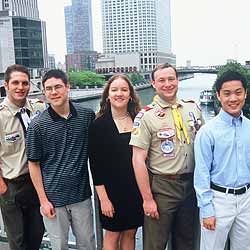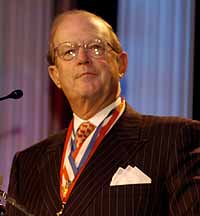Spotlight on Service and Growth
By Jon C. Halter
Photographs by Michael Roytek and John R. Fulton Jr.
Scouters at the BSA National Annual Meeting in Chicago focus on the new Good Turn for America and on ways to boost Cub Scout membership.
- Silver Buffalo Awards
- John C. Cushman III Is New BSA President
- Speakers Recall Influence of Scouting
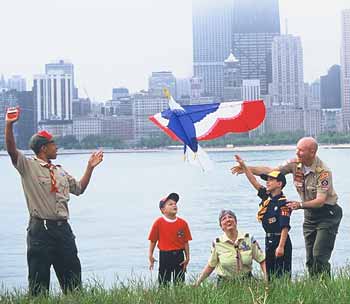 On the Windy City's North Street Beach, national meeting attendees Margaret Eacker, from Washington State's Blue Mountain Council, and John Ertel, of the Baltimore Area Council, help Boy Scout Chandler Gilbert, Tiger Cub Frank Kaminski, and Cub Scout Emilio Mejias, from the host Chicago Area Council, launch an eagle-shaped kite. Photograph By John R. Fulton Jr. |
Downtown Chicago provided a spectacular setting for the 2,000 Scouters and spouses who gathered at the Hyatt Regency in May for the 85th National Annual Meeting of the Boy Scouts of America.
Attendees were within walking distance of spectacular skyscrapers like the 110-story Sears Tower, scenic views from along the Chicago River and Lake Shore Drive, and the more than 460 stores in the city's apply named Magnificent Mile shopping district.
But a glance at the morning newspaper or evening TV newscast reminded Scouters that the Chicago area, as well as the rest of the United States, has social and economic problems that create a greater need than ever for Scouting's values-based program of character and leadership training.
At Friday's annual business meeting, Chief Scout Executive Roy L. Williams reviewed the successes of 2003 and the tasks ahead.
"During the past two years, in the aftermath of 9/11, the stock market crash, and leadership standards debate, we've had some pretty good years," he reassured the Scouting volunteers and professionals, representing some 309 local councils.
As examples, he cited the opening of the new National Scouting Museum in Irving, Tex.; the fact that local council Friends of Scouting campaigns grew $12 million; that local council and National Council camps continued to set all-time attendance records; and the continued development of resources, ranging from the Tiger Cub handbook in Spanish to the availability of professional training online.
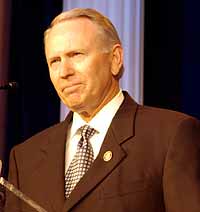 Roy L. Williams |
"In 2003, operating funds in councils went up eight million dollars," he added, "and 309 local council total net assets increased by $132 million.
"Not bad considering what we've been through; most nonprofits in America would trade places with the BSA in a second. We're strong and getting stronger, thanks to great volunteers and staff."
But challenges loom, in particular the need to increase Cub Scout membership. "We're going to turn Cub Scouting around," Williams said, "but we need all 1.3 million of you to help."
The keys to successful Cub Scout recruiting are "great programs that retain kids" and "taking charge of recruiting youth and leaders," he noted. "But, in my opinion, for far too long in many councils, membership [recruitment] has been delegated to professional staff.
"That has to change, and we challenge you [volunteers] to lead your council to grow...To that end] we've asked volunteer leadership in each council to set a recruitment goal...[and] to build strong committees focused on recruitment and retention."
A call to service
A key tool for emphasizing the positive things that Scouts do each and every day is Scouting's Good Turn for America, which is nothing less than "the most important issue that we've undertaken in almost a decade," Williams said.
The BSA "national call to service," launched in February 2003, "is more than just a service issue," Williams point-ed out. "It's an opportunity to focus the entire national conversation on Scouting...by [our] basically doing what we've always done, serving our communities, and by working with other service organizations, such as Habitat for Humanity, The Salvation Army, and the Red Cross."
Since February, Scout units have been entering service hours online at www.goodturnforamerica.org.
"With this kind of information [available] and these strategic alliances, we can open doors to the community that never before existed," Williams concluded. "And Good Turn for America is the key to achieve these goals."
Recruitment goals
At Friday's Leadership Luncheon, the BSA's 309 local councils announced the recruitment goals to be reached by the end of 2004 which Roy Williams had referred to in his remarks at the business meeting. Council leaders also committed to finding innovative ways to get the good news about Scouting to more parents, families, and community organizations.
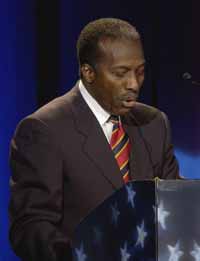 Roy S. Roberts |
The luncheon hosts were BSA President Roy S. Roberts and National Commissioner Rick Cronk, who pointed out that, despite the BSA's many successes in 2003, areas remain where progress is needed.
For example, "In 2003 we had only 59 percent of our Scouting units achieve the Quality Unit Award, and only 38 percent of our direct contact leaders were trained," Roberts reported.
"One of our priorities must be to make sure that all packs, troops, teams, and crews receive the services and support they need to provide a great program for their youth," Roberts added. But "even with the best program in town, young people cannot benefit from it if they don't know about it."
According to BSA research, "60 percent of parents surveyed told us they had never considered enrolling their kids because they simply were never asked," while "88 percent of non-Scouting parents say that no one ever talked to them about their kids joining Scouting," Roberts said. "We have to ask, and we have to ask effectively," he said.
"It is clear that we have a gap in the effectiveness of our recruiting—a gap in our effort to 'Give Every Kid a Chance'...and we must find ways to ask one youth at a time and multiply that effort by a thousandfold," Cronk summed up.
Council recruitment commitments were announced by representatives from each area in the BSA's four regions, with the result a goal to add 769,053 new traditional youth and 313,081 new participants—a total of 1,082,134 new members—by the end of 2004.
Sharing success
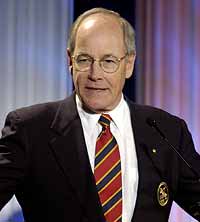 Rick Cronk |
In a workshop on Cub Scout recruiting, Scouters heard about successful programs from the Black Hills Area Council (Rapid City, S.D.); Detroit Area Council; East Texas Area Council (Tyler, Tex.); and Monmouth Council (Oakhurst, N.J.).
The Cub Scouting session was one of 16 workshops and five seminars that focused on the tools and methods for achieving the goals of the BSA's current Strategic Plan's critical issues. In the exhibit area, Scouters visited with representatives from the National Council and other sources to learn about all areas of Scouting. Displays included the latest merchandise from the Supply Division; details on Cub Scouting, Boy Scouting, Venturing, high adventure programs, and international Scouting; opportunities for participation in Good Turn for America; resources available from Risk Management, Health and Safety, Scoutreach, Relationships, and Finance Support; the National Scouting Museum in Irving, Tex.; and a sampling of the newest features from Boys' Life.
Honoring character and service
Friday's recognition banquet spotlighted the recipients of the Silver Buffalo Award, the BSA's highest honor for distinguished service to youth at the national level, and the five winners of the national Young American Awards, honoring young people for service, character, and accomplishment (see sidebar); and introduced new BSA President John C. Cushman III (see sidebar).
At the business meeting earlier in the day, Chief Scout Executive Roy L. Williams had expressed his gratitude to Scouting's countless volunteer leaders for continuing to make a difference in the lives of young people. He also had reminded them that the need for such dedicated service was greater than ever.
"People ask me about my vision of the Boy Scouts of America, and I tell them I see a growing movement of caring volunteers who feel good about being involved in something greater than themselves," he had said. "And I tell them that Scouting's future is brighter because there will always be a great demand for movements that instill honor, respect, patriotism, and duty in young people.
"You're here today, just as I am, because you know that Scouting makes a difference in the lives of everyone it touches. It's an honor and a privilege to serve with you in this great movement.
"Thank you for your leadership and for doing all that you do for the youth of America."
Jon C. Halter is the editor of Scouting magazine.
Silver Buffalo AwardsThe BSA honors adult leaders and young people for high achievement and service.
| ||||||||||||||||||||||||
John C. Cushman III Is New BSA President
The BSA National Annual Meeting's closing banquet featured a tribute to retiring BSA President Roy S. Roberts and a welcome to new President John C. Cushman III. In his review of Roberts's two years as BSA president, Chief Scout Executive Roy L. Williams said Roberts "brought insight, enthusiasm, and an incredible concern for young people" to the position. "It's hard to believe the time has passed so quickly," Roberts said in his farewell remarks. "During my time in Scouting I've experienced the boundless optimism of our volunteers and the genuine enthusiasm of our members. I've looked on the faces of thousands of young people and seen that the spirit of Scouting is alive and well and stronger than ever. "I leave you this evening confident that through the challenges and opportunities ahead, this movement will continue to succeed in its mission of building better young people." MEET the new presidentA recipient of the Silver Buffalo and Distinguished Eagle Scout Awards, new BSA President John C. Cushman III has held adult leadership positions at local, regional, and national levels. "I had the good fortune to have a terrific experience in Scouting with my twin brother, Lou, in Troop 12 in Montclair, N.J.," Cushman said. "My love of and respect for the outdoors come from the extraordinary experiences I had in Scouting. I was able to pass that love on to my four Eagle Scout sons." Nominated to the BSA's National Executive Board in 1993, Cushman has served in various leadership positions, including chairman of the National Exploring Committee. Over the past decade, he has served on the inspection team for the Northern Tier High Adventure Program, the visitation team for Philmont Scout Ranch in New Mexico, and as president of Learning for Life in the Western Region and the Los Angeles Area Council. After beginning his career in 1963 in New York City with Cushman & Wakefield, Inc., a global real estate services firm, he helped open the company's Los Angeles office in 1967. Cushman then co-founded Cushman Realty Corp. with his twin brother, Louis, in 1978. In 2001, their company merged with Cushman & Wakefield, Inc., and Cushman was elected chairman of the board of that corporation. He was recognized by the National Real Estate Investor in 1998 as "One of 40 Who Made a Difference" in the real estate industry. "Over the last few days we've spent a great deal of time talking about membership," he told the banquet audience. "And membership is all about recruiting the little guys to the Scouting movement—it's all about Cub Scouts. "Tonight is a celebration of the success of the past year and a celebration of Scouting's future," he said. "Thanks to you, the future is bright. I look forward to working shoulder to shoulder with each and every one of you as we strive to deliver the kind of Scouting experience that builds confidence in young people who in turn build stronger families and stronger communities." Cushman and his wife, Jeanine, reside in Pasadena, Calif., where Mrs. Cushman, a recipient of the Silver Beaver Award, serves on the board of the San Gabriel Valley Council. |
Speakers Recall Influence of ScoutingThe Duty to God Breakfast and the Americanism Duty to Country Breakfast (hosted by the National Eagle Scout Association) are two highlight sessions at every BSA National Annual Meeting. In Chicago, the Duty to God speaker was Dr. James B. Buskirk, Eagle Scout and professor of evangelism and preaching at Asbury Theological School, Wilmore, Ky. He recalled his Scouting experiences as a youth in Louisville, Miss., and how an assistant Scoutmaster who caught him carrying out "a bit of mischief" invited him to join the troop (in lieu of informing his father, a local preacher, of his misbehavior). "As a result, I became a very enthusiastic Scout, enjoying the meetings, and camping, and all." But Scouting's greatest impact came from "an incredible, wonderful Scoutmaster, Jimmy Ellis," who asked him to serve as senior patrol leader of a new troop of younger Scouts. "I couldn't believe he was asking me to do that," the Rev. Buskirk recalled. "I was extremely timid, I talked fast, and I stuttered sometimes when I talked. But I agreed to do that, and [as a result], I know that I never would have gone into the ministry if it hadn't been for Scouting." Of the many things he has been called up to do as adult, Rev. Buskirk said, "I found the initial training for each one of these things in Scouting." As examples, he cited planning, managing people, teaching, and raising a budget. "Thank God for Scouting," he concluded. "I think it's incredibly good for young people and for adults, and a grateful heart this morning says 'thank you' to all of you who share in Scouting and bless young men, timid and stubborn and undeveloped, like I was." *** Guest speaker at the NESA breakfast was retired U.S. Army General Tommy R. Franks, a former Life Scout and longtime supporter of Scouting who led U.S. battle forces in Afghanistan and Iraq. General Franks recalled his Scouting experiences growing up in Midland, Tex. "Buffalo Trail Council, Troop 158, St. Paul Methodist Church—[it was] at that time [of] my upbringing where I gained a sense of values and was first exposed to the notion of 'be prepared.' "I believe that the best military leaders...a and the best politicians that we have in this country have grown up as Scouts," he said. "The millions of Scouts we have in this country give me faith and confidence that we'll be able to answer the question which I'm frequently asked by the media: Are we paying too high a price to wage this global war on terrorism?" he said. "My answer is that we are not sacrificing beyond [what is required] because the prize we seek, as we have moved two and half plus years beyond 9/11/01 is a way of life in this country. "...This global war on terrorism is about America's future; it is about our grandchildren ...and their grandchildren and generations yet unborn. So that in a hundred years America can have the freedom and liberty which underpins the Scouting program as we know it—selfless service, citizenship, love of country, patriotism, the American flag....And no price is too great to secure that for our kids." My wife and I are most blessed...to have people such as you, dedicated and devoted to youth of America....I am honored to have been asked to be with you here today [because] there is no greater calling on this planet than the love of youth, in a way that we do not find in so many parts of the world..." *** Scouters at the Americanism Duty to Country Breakfast also heard from Eagle Scout Joseph R. Quick, from Troop 85 in the Indianhead Council, St. Paul, Minn., and recipient of the 2003 Mabel and Lawrence S. Cooke Eagle Scout Scholarship. The four-year $48,000 grant represents the top award among the 105 college scholarships, totaling more than $370,000, in the NESA Eagle Scout scholarship program. "As an Eagle Scout, the Scout Oath and Law, the motto and slogan...become a guide for everyday life [and] the notion of duty, integrity, and service become fundamental parts of every day," Joseph said. "By serving these ideals, Scouts—and Eagle Scouts especially—become well-rounded, responsible leaders—not only in our troops and councils, but also in our communities, our nation, and our world." The influence of Scouting "in many ways has made me the person I am today," he added. "Scouting gave me opportunities to visit and explore new places, to interact with new people, and to learn and share my new knowledge with others." |
September 2004 Table of Contents
Copyright © 2004 by the Boy Scouts of America. All rights thereunder reserved; anything appearing in Scouting magazine or on its Web site may not be reprinted either wholly or in part without written permission. Because of freedom given authors, opinions may not reflect official concurrence.











